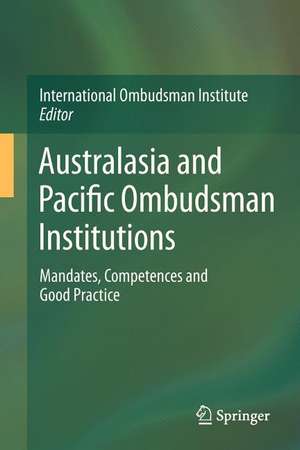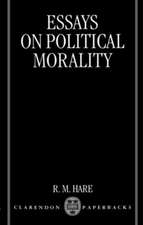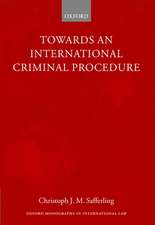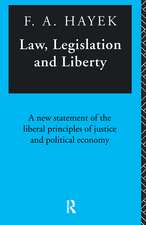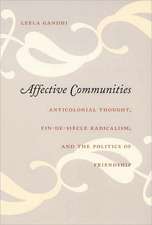Australasia and Pacific Ombudsman Institutions: Mandates, Competences and Good Practice
Editat de International Ombudsman Instituteen Limba Engleză Paperback – 9 ian 2013
- Legal basis, legal status and organisation,
- Mandate, object of control and standard of control,
- Powers, including legal quality and impact of the outcomes of investigative procedures,
- Relationship to the administration, the judiciary and the legislator, and
- Special characteristics.
Part 2 is based on information provided by the Institutions themselves in questionnaires sent out at the outset of the study, an analysis of the respective establishing acts and other relevant laws, and on relevant scientific publications and the Institutions’ Annual Reports. The reports also refer to relevant legal provisions and include websites addresses for ease of reference.
Preț: 390.46 lei
Nou
Puncte Express: 586
Preț estimativ în valută:
74.72€ • 79.90$ • 62.30£
74.72€ • 79.90$ • 62.30£
Carte tipărită la comandă
Livrare economică 17 aprilie-01 mai
Preluare comenzi: 021 569.72.76
Specificații
ISBN-13: 9783642338953
ISBN-10: 364233895X
Pagini: 336
Ilustrații: XVII, 316 p. 13 illus.
Dimensiuni: 155 x 235 x 18 mm
Greutate: 0.47 kg
Ediția:2013
Editura: Springer Berlin, Heidelberg
Colecția Springer
Locul publicării:Berlin, Heidelberg, Germany
ISBN-10: 364233895X
Pagini: 336
Ilustrații: XVII, 316 p. 13 illus.
Dimensiuni: 155 x 235 x 18 mm
Greutate: 0.47 kg
Ediția:2013
Editura: Springer Berlin, Heidelberg
Colecția Springer
Locul publicării:Berlin, Heidelberg, Germany
Public țintă
Professional/practitionerCuprins
Part 1 Comparative Analysis of the Ombudsman Institutions: Introduction.- Legal Framework.- Mandate.- Powers.- Awareness and Outreach.- Good Practice Examples.- Part 2: Reports on Different Jurisdictions: Australia Commonwealth Ombudsman.- Australia Ombudsman New South Wales.- Australia Northern Territory Ombudsman.- Australia Queensland Ombudsman.- Australia South Australian Ombudsman.- Australia Tasmanian Ombudsman.- Australia Victorian Ombudsman.- Australia Western Australian Ombudsman.- Hong Kong (Special Administrative Region of China) Ombudsman.- Cook Islands Ombudsman.- New Zealand Ombudsmen.- Papua New Guinea Ombudsman Commission.- Samoa Ombudsman.- Taiwan – Control Yuan.- Tonga Commissioner for Public Relations.- Vanuatu Ombudsman.- Annex.
Textul de pe ultima copertă
Commissioned by the International Ombudsman Institute (IOI), the Ludwig Boltzmann Institute of Human Rights (BIM) in Vienna conducted a comparative analytical study on Ombudsman Institutions in the Australasia and Pacific region between January 2011 and April 2012. In Part 1, this book provides an analytical comparison of the public sector Ombudsman Institutions in Australia (the Commonwealth Ombudsman and the state/territory Ombudsmen of all Australian states as well as of the Northern Territory and the ACT), the Cook Islands, Hong Kong, New Zealand, Papua New Guinea, Samoa, Taiwan, Tonga and Vanuatu. In addition to a comparative analysis showing the partial heterogeneity of the Institutions, a comprehensive overview of common features, and explorations of the specifics and peculiarities of the Institutions, Part 2 presents separate reports on the 16 different jurisdictions featuring their main functions as follows:
- Legal basis, legal status and organisation,
- Mandate, object of control and standard of control,
- Powers, including legal quality and impact of the outcomes of investigative procedures,
- Relationship to the administration, the judiciary and the legislator, and
- Special characteristics.
Part 2 is based on information provided by the Institutions themselves in questionnaires sent out at the outset of the study, an analysis of the respective establishing acts and other relevant laws, and on relevant scientific publications and the Institutions’ Annual Reports. The reports also refer to relevant legal provisions and include websites addresses for ease of reference.
- Legal basis, legal status and organisation,
- Mandate, object of control and standard of control,
- Powers, including legal quality and impact of the outcomes of investigative procedures,
- Relationship to the administration, the judiciary and the legislator, and
- Special characteristics.
Part 2 is based on information provided by the Institutions themselves in questionnaires sent out at the outset of the study, an analysis of the respective establishing acts and other relevant laws, and on relevant scientific publications and the Institutions’ Annual Reports. The reports also refer to relevant legal provisions and include websites addresses for ease of reference.
Caracteristici
Includes supplementary material: sn.pub/extras
